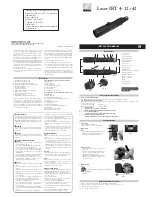
6
crosshairs of the finder scope. Look again into the telescope’s
eyepiece and see if the object is still centered there as well. If it
isn’t, repeat the entire process, making sure not to move the
main telescope while adjusting the alignment of the finderscope.
The finder scope alignment needs to be checked before every
observing session. This can easily be done at night, before
viewing through the telescope. Choose any bright star or plan-
et, center the object in the telescope eyepiece, and then
adjust the finder scope’s alignment thumbscrews until the star
or planet is also centered on the finder’s crosshairs. The find-
er scope is an invaluable tool for locating objects in the night
sky since it has a much wider field-of-view than the main tele-
scope tube.
Focusing the Finder Scope
If, when looking through the finder scope, the images appear
somewhat out of focus, you will need to refocus the finder
scope for your eyes. Turn the viewing end of the finder scope
clockwise or counter-clockwise as needed to focus the finder
scope on a distant object (1/4 mile away or more).
5. Using Your Telescope -
Astronomical Observing
Choosing an Observing Site
When selecting a location for observing, get as far away as
possible from direct artificial light such as street lights, porch
lights, and automobile headlights. The glare from these lights
will greatly impair your dark-adapted night vision. Set up on a
grass or dirt surface, not asphalt, because asphalt radiates
more heat. Heat disturbs the surrounding air and degrades
the images seen through the telescope. Avoid viewing over
rooftops and chimneys, as they often have warm air currents
rising from them. Similarly, avoid observing from indoors
through an open (or closed) window, because the tempera-
ture difference between the indoor and outdoor air will cause
image blurring and distortion.
If at all possible, escape the light-polluted city sky and head
for darker country skies. You’ll be amazed at how many more
stars and deep-sky objects are visible in a dark sky!
“Seeing” and Transparency
Atmospheric conditions vary significantly from night to night.
“Seeing” refers to the steadiness of the Earth’s atmosphere at
a given time. In conditions of poor seeing, atmospheric turbu-
lence causes objects viewed through the telescope to “boil”. If,
when you look up at the sky with just your eyes, the stars are
twinkling noticeably, the seeing is bad and you will be limited to
viewing with low powers (bad seeing affects images at high
powers more severely). Planetary observing may also be poor.
In conditions of good seeing, star twinkling is minimal and
images appear steady in the eyepiece. Seeing is best over-
head, worst at the horizon. Also, seeing generally gets better
after midnight, when much of the heat absorbed by the Earth
during the day has radiated off into space.
Especially important for observing faint objects is good “trans-
parency” - air free of moisture, smoke, and dust. All tend to
scatter light, which reduces an object’s brightness. One good
way to tell if conditions are good is by how many stars you can
see with your naked eye. If you cannot see stars of magnitude
3.5 or dimmer then conditions are poor. Magnitude is a meas-
ure of how bright a star is, the brighter a star is, the lower its
magnitude will be. A good star to remember for this is Megrez
(mag. 3.4), which is the star in the ‘Big Dipper’ connecting the
handle to the ‘dipper’. If you cannot see Megrez, then you
have fog, haze, clouds, smog, or other conditions that are hin-
dering your viewing. (See Figure 5)
Tracking Celestial Objects
The Earth is constantly rotating about its polar axis, complet-
ing one full rotation every 24 hours; this is what defines a
“day”. We do not feel the Earth rotating, but we can still tell that
it is at night by seeing the apparent movement of stars from
east to west.
When you observe any astronomical object, you are watching
a moving target. This means the telescope’s position must be
continuously updated over time to keep an object in the field of
view. When viewing the with the SpaceProbe 3 Altaz, you will
need to give the tube a light tug or push in azimuth as well as
an occasional turn of the altitude micro-motion thumbwheel to
keep the object in the field of view. (Make certain the azimuth
lock knob is slightly loosened before moving the scope in the
azimuth position). Objects will appear to move faster at higher
magnifications, when the field of view is narrower. Remember
that objects are inverted in the telescope, so when you move
the telescope in one direction, the object in the eyepiece will
move in the opposite direction than you would normally expect.
This takes some getting used to, but becomes second nature
after a few nights out with the telescope.
Cooling the Telescope
All optical instruments need time to reach “thermal equilibri-
um.” The bigger the instrument and the larger the temperature
change, the more time is needed. Allow at least 30 minutes for
your telescope to cool to the temperature outdoors.
2.4
1.7
3.4
2.4
4.9
1.9
1.9
2.5
Figure 5. Megrez connects the Big Dipper’s
handle to it's “pan”. It is a good guide to how
conditions are. If you can not see Megrez (a
3.4 mag star) then conditions are poor.


























